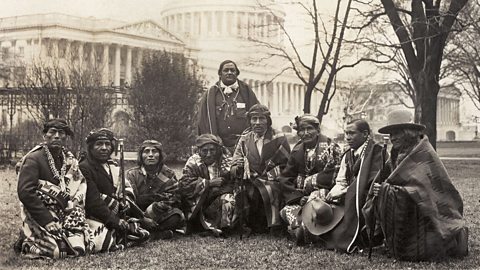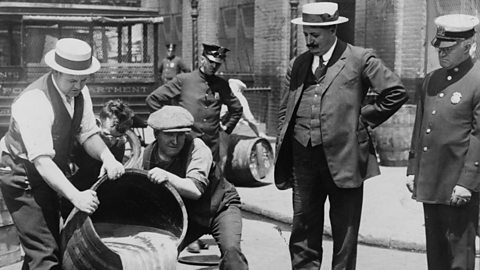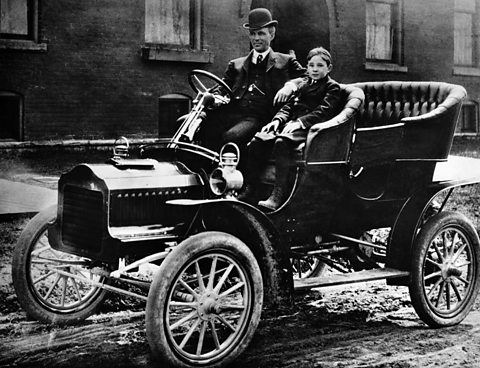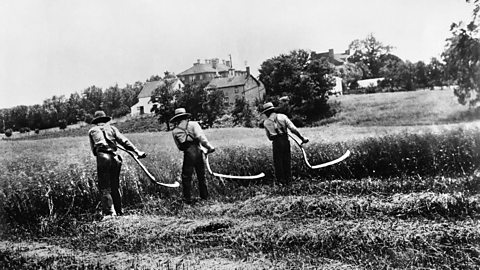Native Americans

Native American is the name given to the original inhabitants of the North American continent.
At one stage, there were almost two million people who were Native American.
However, from the 1830s onwards, the United States government wanted to expand its territory westward and argued that its white citizenA person who is legally a member of a town, city, or country. were entitled to claim this land as their own.
This was based on their belief that Christian values were superior and more important than those of the Native Americans, who they called âIndiansâ.
This meant taking and developing the land where the Native American tribes lived.
This caused conflict throughout the 19th century, but the Native Americans were no match for the United States government and its armies.
Reservations
After 1851, all Native Americans had to live on territories called reservations - these were small areas of tribal land controlled by the US governmentâs Bureau of Indian Affairs.
This was often poor quality land.
According to United States law, the Native Americans were not citizenA person who is legally a member of a town, city, or country..
This meant that they did not have the rights or protections that other Americans had.
White businessmen took advantage of this and extracted natural resources such as coal from the reservations, with the help of the Bureau of Indian Affairs.
The Native Americans could not legally get any payment or compensation for this.
Life on the reservation came to be characterised by disease and poverty.
Assimilation
To assimilate means to become part of another group, culture or country.
This is the policy that the United States government used towards the Native Americans throughout the 19th century.
It believed that the easiest way to end the âIndian problemâ was to force the Native Americans to be more like them.
Once again, this rested upon the idea that the âwhite Christianâ culture of the United States was superior to that of the Native Americans and therefore this was the path that everybody should follow.
The reality was that assimilating the Native Americans meant destroying their unique cultureCulture refers to the ideas, customs and social behaviour of a particular people or society..
This was quite deliberate.
In fact, the buffalo herds in North America were slaughtered in order to destroy the tribes that relied on them.
Education
One of the ways the United States government attempted to assimilateTo become part of another group, culture or country the Native American people was through education.
Native American children were to attend new boarding schools.
The goal of this process was to teach them to be like the white settlers rather than Native Americans.
In the words of Henry Pratt, a former cavalry officer who opened one of the boarding schools, âkill the Indian in him, and save the manâ.
Attending American schools was voluntary, but Native American parents were pressurised by the government to send their children to these schools.
There were over 150 such boarding schools. They put in place a number of practices:
Children from the same tribe were separated to destroy any sense of tribal identity.
Children were given European-style haircuts and were given new English names.
If they were found speaking their own language, they were beaten.
They were made to go to Christian church services.
They were encouraged to mock their parentsâ values.
The aim of the boarding schools was to destroy the Native American identity of these young people.
The American government wanted the Native way of life to disappear.
Meriam report
In 1928, an investigation called the Meriam Report detailed the difficulties of Native American lives.
In terms of how they were treated by others, life expectancy, health, literacyThe ability to read and write. , employment and wealth, they were much worse off than white Americans.
The report recommended:
That Native American children should be taught about their own culture and history by teachers who valued tribal ways.
That only older children should attend the non-reservation boarding schools.
That younger children should attend a community school near home.
That the Bureau of Indian Affairs must provide young people and parents with tools to adapt to both the white and Native American world.
Improvements

There were some improvements made to Native American life from the mid-1920s:
In 1924, all Native Americans were finally given American citizenship through the Snyder Act.
In 1929, the Indian Commissioner, Charles Rhoads, implemented the recommendations of the Meriam Report.
In 1933, President Franklin Roosevelt offered an âIndian New Deal'. This included appointing John Collier as Commissioner of Indian Affairs, ending the policy of assimilation with the passage of the 1934 Indian Reorganisation Act which gave Native Americans a measure of self-government.
However, there was to be no return to tribal life and the life chances of Native Americans would remain low.
Which law or report?
Find the answer in the image
Test your knowledge
More on Life in the United States of America, 1920-33
Find out more by working through a topic
- count4 of 9

- count6 of 9

- count7 of 9
